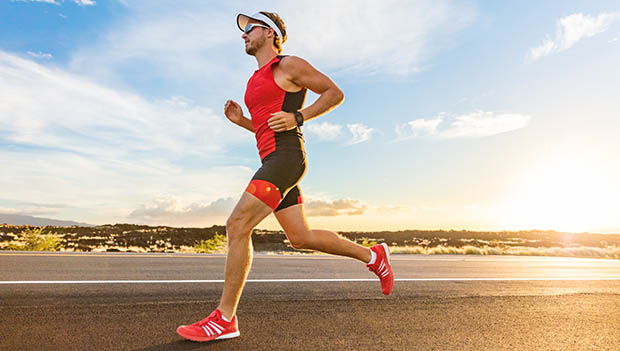
Triathletes for the most part are a healthy group of people. From all the hours swimming, cycling and running on a weekly basis, it's clear that most triathletes put their physical heath at the top of their priority list.
This often includes healthy eating, a higher-than-average sleep quota and lots of post-workout recovery tactics like icing, stretching and strength and mobility work.
But while it's important to find that sweet spot between breaking the body down and recovering to manifest performance gains, it's just as important to look at the long-term picture—especially when it comes to your skin.
From UV exposure to blisters and chafing, racing and training for a triathlon puts some serious wear and tear on the largest (and most vulnerable) organ in the body.
We've listed a few things to keep in mind that will help minimize the impact this sport has on your skin, with the ultimate goal not just to keep you looking and feeling at your best, but prevent any long-term issues, too.
Please note these are general suggestions. Consult your doctor immediately if you have any questions regarding any potential health or skin issues.
Sun Exposure
It's obvious that triathlon as a sport requires a large amount of time spent training and racing in the sun, and what may seem like just an hour or two a day can really add up over time. This puts triathletes at a higher-than-average risk for developing skin cancers, and at the very least too much sun exposure can impact how your body regulates temperature (thus reducing performance).
There are several simple things you can do that make a world of difference. Most importantly, reduce your risk of sun-related issues by using a reef-safe sports sunscreen of at least SPF 30 (we like Protekt), and reapply every two hours. Especially in the summer months when sun is more intense and higher in the sky, try to schedule your workout in the morning or evening, not at high noon (or work out indoors when appropriate).
Also, more coverage works better than sunscreen, so long-sleeved speedsuits, sun sleeves and hats are always a good idea.
Chlorine
While some pools use a salt water-based sanitation system, most public pools are still using chlorine to keep the water clean. This means that triathletes who swim a few days a week will be exposing their skin to harsh chemicals for several hours.
To help prevent itchy, dry and discolored skin and damaged hair, rinse with fresh non-chlorinated water before and immediately after getting in the pool. Also, keep a purifying chlorine removal shampoo, conditioner and body wash (we like TYR's line of personal care) in your bag for use after each swim.
Once your skin has been cleaned and is dry, use a lotion to rehydrate (make a habit of doing this before bed, too).
Chafing/Blisters
Especially true for long-distance efforts or when there's lots of humidity in the air, blisters and chafing can be a big issue for triathletes. Whether it's irritation around the neck and under the arms from a wetsuit, skin-to-skin rubbing like between the thighs, or something else, chafing hurts and can dramatically reduce race performance (and raw skin can get infected if not taken care of properly).
Use an anti-chafing balm or cream like Body Glide, and apply generously around sensitive areas. Also, opting for tighter-fitting clothing (but not too tight) can help prevent chafing.
Blisters most commonly occur on the feet, and can also be prevented by pairing shoes that fit properly (and are broken in) with synthetic socks (we love socks from Swiftwick). If you ran up the beach and your feet are covered in sand and dirt, be sure to rinse them off as best as possible so you don't agitate your skin on the run.
Click here to read more about how to prevent blisters and chafing—specifically for runners.
READ THIS NEXT: Home Remedies for Saddle Sores and Chamois Rash


